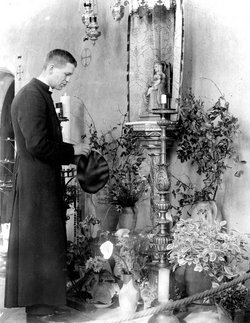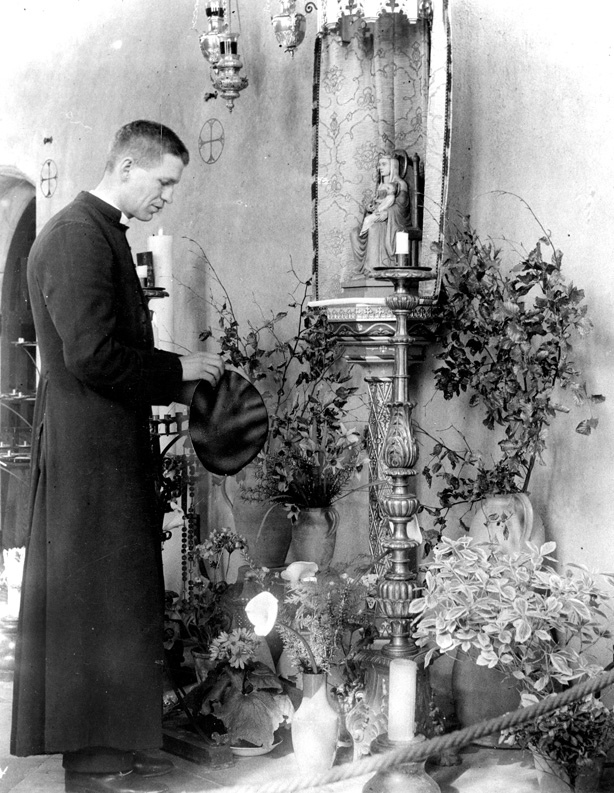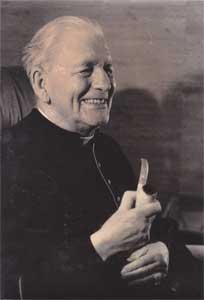Fr. Bruno was born in Devonshire in 1906. He entered a monastery run by the Anglican Benedictines at Pershore, later at Nashdom, where he persued a deep interest in the early Church Fathers. According to Bishop Wheeler, Father Bruno was never quite comfortable in the Church of England, and during a visit to the Slipper Chapel in Walsingham, he decided to take instruction from the Carthusians at Parkminster, and was eventually received into the Catholic Church at Sacred Heart, Hove.
He resided first at Downside Abbey, and then in the Certosa of Florence until the breakdown of his health compelled him to become a student again at Beda College, Rome, where he took instruction for the secular priesthood. After his ordination in 1935, he was appointed by the Bishop of Northampton, Dr. Youens, as first administrator of Walsingham, with a mandate to establish a shrine at Slipper Chapel. During the period at Slipper Chapel from 1935 until 1943, Fr. Bruno began an apostolate and inspired many seminarians to join him on pilgrimages around the country. He then moved back to Italy, where he was appointed by Pope Paul VI as canon of the Basilica of Santa Maria in Trastevere with the title of Monsignor.
A gifted writer, he asked Thomas Merton's help in putting together a book of translations of "The Letters of St. Bernard of Clairvaux". Inspired by "The Children of the Sun," a book by Morris West about Don Mario Borelli in the slums of Naples, Father Bruno helped to found the John Henry Newman College, a residence hall for students at the University of Naples. With the help of Cardinal Wright, he took up residence in the Jesuit College in Naples and supported by the Neapolitan Oratory began his apostolate. Over the years, the name of "Padre Bruno" came to be known and loved. However, with time, his health deteriorated to the extent that eventually Cardinal Wright persuaded him to close Newman College. Fr. Bruno wrote of his experience at the College and about its closing in his brief essay entitled, "What Happened to Collegio Newman?" After writing other books on Bernard of Clairvaux and on prayer, James wrote an autobiography entitled "Asking for Trouble" in 1962. Other publications include "How to Pray and Other Conferences" (1948), "The One Thing Necessary" (1954), and "Seeking God" (1960).
Failing health finally compelled Monsignor Bruno to relinquish his duties as canon, and he returned to England. He died on March 16, 1984, aged 77, among friends in Brighton, and was buried at his beloved Downside Abbey.
During the Spanish Civil War, Fr. Bruno travelled to the front line to say Mass, where the Marquis de Villada gave him his red beret to hang before the Shrine of Our Lady of Walsingham in the Slipper Chapel, in thanksgiving for his having served right through the war unscathed. Fr. Bruno honoured the Marquis' request in March 1939.
Fr. Bruno was born in Devonshire in 1906. He entered a monastery run by the Anglican Benedictines at Pershore, later at Nashdom, where he persued a deep interest in the early Church Fathers. According to Bishop Wheeler, Father Bruno was never quite comfortable in the Church of England, and during a visit to the Slipper Chapel in Walsingham, he decided to take instruction from the Carthusians at Parkminster, and was eventually received into the Catholic Church at Sacred Heart, Hove.
He resided first at Downside Abbey, and then in the Certosa of Florence until the breakdown of his health compelled him to become a student again at Beda College, Rome, where he took instruction for the secular priesthood. After his ordination in 1935, he was appointed by the Bishop of Northampton, Dr. Youens, as first administrator of Walsingham, with a mandate to establish a shrine at Slipper Chapel. During the period at Slipper Chapel from 1935 until 1943, Fr. Bruno began an apostolate and inspired many seminarians to join him on pilgrimages around the country. He then moved back to Italy, where he was appointed by Pope Paul VI as canon of the Basilica of Santa Maria in Trastevere with the title of Monsignor.
A gifted writer, he asked Thomas Merton's help in putting together a book of translations of "The Letters of St. Bernard of Clairvaux". Inspired by "The Children of the Sun," a book by Morris West about Don Mario Borelli in the slums of Naples, Father Bruno helped to found the John Henry Newman College, a residence hall for students at the University of Naples. With the help of Cardinal Wright, he took up residence in the Jesuit College in Naples and supported by the Neapolitan Oratory began his apostolate. Over the years, the name of "Padre Bruno" came to be known and loved. However, with time, his health deteriorated to the extent that eventually Cardinal Wright persuaded him to close Newman College. Fr. Bruno wrote of his experience at the College and about its closing in his brief essay entitled, "What Happened to Collegio Newman?" After writing other books on Bernard of Clairvaux and on prayer, James wrote an autobiography entitled "Asking for Trouble" in 1962. Other publications include "How to Pray and Other Conferences" (1948), "The One Thing Necessary" (1954), and "Seeking God" (1960).
Failing health finally compelled Monsignor Bruno to relinquish his duties as canon, and he returned to England. He died on March 16, 1984, aged 77, among friends in Brighton, and was buried at his beloved Downside Abbey.
During the Spanish Civil War, Fr. Bruno travelled to the front line to say Mass, where the Marquis de Villada gave him his red beret to hang before the Shrine of Our Lady of Walsingham in the Slipper Chapel, in thanksgiving for his having served right through the war unscathed. Fr. Bruno honoured the Marquis' request in March 1939.
Sponsored by Ancestry
Advertisement
Explore more
Sponsored by Ancestry
Advertisement



